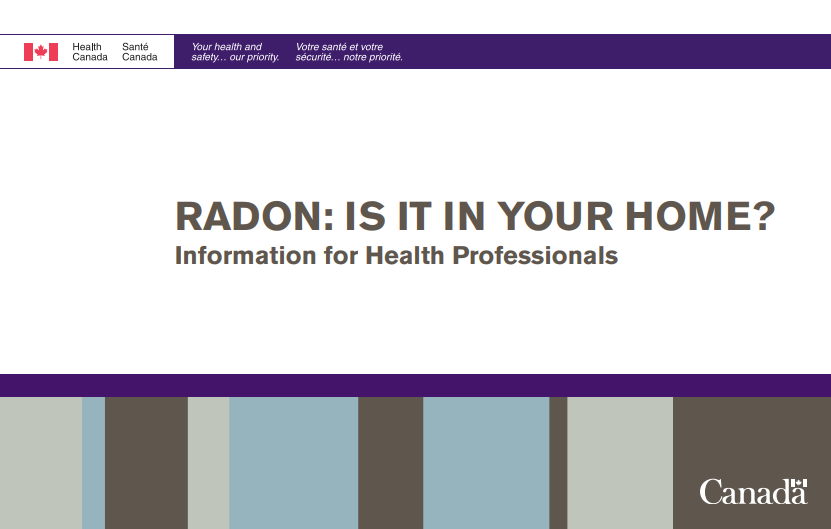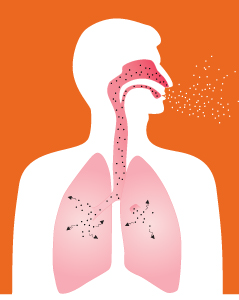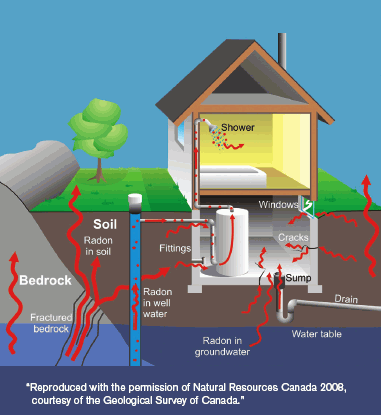Radon: Is it in your home? Information for Health Professionals

Download the alternative format
(PDF format, 420 KB, 6 page)
April 2018
ISBN: 978-0-660-25828-7
Cat.: H128-1/08-554-4E-PDF
Pub.: 170491
Organization: Health Canada
Health Canada, the World Health Organization, the US Environmental Protection Agency, and many other respected international authorities all agree – Radon is the number 1 cause of lung cancer for non-smokers.
Epidemiological studies confirm that there is a risk of radon-induced lung cancer from indoor radon levels found in homes and public buildings across Canada. Health Professionals are a respected and trusted voice, please encourage your patients to take action to reduce their radon exposure.
As a health professional, your patients may ask you about the health risks of radon, and the need to test their homes. This fact sheet provides you with some information you can use to answer their questions.
What is Radon?
Radon is a colourless, odourless, radioactive gas that occurs naturally in the environment. It comes from the natural breakdown of uranium in soils and rocks. When radon is released from the ground into the outdoor air, it is diluted and is not a concern. However, in enclosed spaces like homes, it can sometimes accumulate to high levels, which can create a health risk. The air pressure inside a dwelling is usually lower than in the soil surrounding the foundation. This difference in pressure draws air and other gases, including radon, from the soil. Radon can enter homes through cracks in foundations, construction joints, gaps around pipes, sump pumps and drains, etc. The Canadian guideline for radon in indoor air for dwellings is 200 becquerels per cubic metre (200 Bq/m3).
What are the Health Effects of Radon?
The only known health effect from exposure to radon is the increased risk of developing lung cancer. Radon is the second leading cause of lung cancer, after smoking.
Extensive epidemiological evidence from studies of underground uranium miners, complemented by recent residential radon studies in Europe and North America, have shown that there is a measurable risk of developing lung cancer from radon exposure at levels commonly found in residential homes. This risk exists for both smokers and non-smokers, although malignancy from radon exposure is especially likely to occur in cigarette smokers. The carcinogenicity of radon is supported by a consensus of opinion among national and international health organizations. By informing patients about the health risk posed by radon exposure and encouraging homeowners to test their homes to determine radon levels, health professionals can have a positive impact on the national effort to prevent radon-induced lung cancer.
Figure 1 - Text equivalent
Radon gas entering the lungs: As radon breaks down it forms radioactive particles that can get lodged into your lung tissue as you breathe. The radon particles then release energy that can damage your lung cells. When lung cells are damaged, they have the potential to result in cancer.

How Can Radon Induce Cancer?
If inhaled, radon decay products can become deeply lodged in the lungs, where they emit ionizing radiation which can penetrate the cells of mucous membranes, bronchi, and other pulmonary tissues. The ionizing radiation energy affecting the bronchial epithelial cells is believed to initiate the process of carcinogenesis. Although radon-related lung cancers are mainly seen in the upper airways, radon increases the incidence of all histological types of lung cancer, including small cell carcinoma, adenocarcinoma, and squamous cell carcinoma.
An individual’s risk of getting lung cancer from radon depends mostly on three factors: the level of radon, the duration of exposure, and their smoking habits. Either smoking or radon exposure can independently increase the risk of lung cancer; however, exposure to both greatly enhances that risk.
Risks of Developing Lung Cancer from Radon
The risks are greater for smokers and those exposed to second-hand smoke. The lifetime risks listed in the table on the following page represent the risks of developing lung cancer due to radon exposure and for smokers the combined risk of tobacco use and radon exposure.
Non-smokers exposed to radon at the level of 200 Bq/m3 have a 2% lifetime chance of developing lung cancer. For a smoker, this risk increases to 17% at 200 Bq/m3.
Lifetime Risks to a Smoker Exposed to Radon
Lung cancer risk for lifetime exposure to radon at 800 Bq/m³ 30%
Lung cancer risk for lifetime exposure to radon at 200 Bq/m³ 17%
Lung cancer risk from smoking only 12%
Lifetime Risks to a Non-Smoker Exposed to Radon
Lung cancer risk for lifetime exposure to radon at 800 Bq/m³ 5%
Lung cancer risk for lifetime exposure to radon at 200 Bq/m³ 2%
Lung cancer risk for exposure to radon at low outdoor levels 1%
(Source: Report of the Radon Working Group on a New Radon Guideline for Canada)
The chart below illustrates that the risk for a non-smoker at 800 Bq/m3 is higher than for all common accidental deaths (motor vehicle accidents, drownings, falls, fire and more) combined. We take precautions against accidental deaths by putting on our seatbelts, wearing lifejackets or ensuring that our smoke detectors are working – we should also be testing our homes for radon!

Chart 1
The chart below illustrates the death rate at various levels of Becquerels per cubic metre (50, 200, 400, 800 and 1000). At each level the radon exposure for a non-smoker is compared to other types of death such as; all accidental death combined, aircraft “bush” pilot, climbing Mount Everest and poisoning. The key message in this chart is that the risk for a non-smoker at 800 Bq/m3 is higher than for all common accidental deaths (motor vehicle accidents, drownings, falls, fire and more) combined. We take precautions against accidental deaths by putting on our seatbelts, wearing lifejackets or ensuring that our smoke detectors are working - we should also be testing our homes for radon!
Radon is Easy to Detect and Reduce in a Home

Figure 2 - Text equivalent
This is a diagram of radon movement indoors as well as outdoors. Because radon is a gas, it can move freely through the soil enabling it to escape to the atmosphere or seep into buildings. When radon escapes from the bedrock into the outdoor air, it is diluted to such low concentrations that it poses a negligible threat to health. However, if a building is built over bedrock or soil that contains uranium, radon gas can be released into the building through cracks in foundation walls and in floor slabs, construction joints, gaps around service pipes and support posts, floor drains and sumps, cavities inside walls, and the water supplies. When radon is confined to enclosed or poorly ventilated spaces, it can accumulate to high levels. Radon levels are generally highest in basements and crawl spaces because these areas are nearest to the source and are usually poorly ventilated.
There are two options for testing a house for radon: to purchase a do-it-yourself radon test kit or to hire a radon measurement professional. For either option Health Canada recommends you do a long term test for a minimum of 3 months, ideally during the fall/winter timeframe. Radon testing is easy and inexpensive, long term test kits can be purchased over the phone, online or in store. To find a certified professional or test kit in your area go to: www.takeactiononradon.ca/test
Minimizing the Risk
Health Canada’s research indicates that approximately 7% of homes in Canada have radon levels above the guideline and in many areas across the country that percentage is much higher. If your patients are concerned about exposure to radon gas in their home, they should have their home tested, and take the following steps to reduce their risk:
- If they are a smoker, they should quit smoking.
If they have tested the air in their home and their radon level is above the Canadian guideline, they should take action to lower the level as soon as possible.
Most Radon Problems are Easily Resolved
Techniques to lower radon levels are effective and can save lives. A radon mitigation system can be installed in less than a day and in most homes will reduce the radon level by more than 80% for about the same cost as other common home repairs such as replacing the furnace or air conditioner.
Hire a radon mitigation professional that has been certified under the Canadian National Radon Proficiency Program (C-NRPP) to help you find the best way to reduce the radon level in your home.
http://c-nrpp.ca/find-a-professional or 1-855-722-6777.
Health Canada’s Role
Health Canada has taken a number of steps to protect Canadians from the potential dangers of radon gas. These include education and awareness about radon and the associated health effects, establishing measurement techniques and protocols, conducting research into effects of radon exposure and developing guidelines.
Where Can I Learn More?
Visit the Health Canada Web site canada.ca/radon or call 1-866-225-0709, TTY – 1-800 465-7735 for more information on how to reduce your exposure to radon.